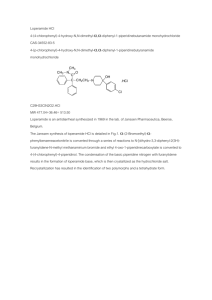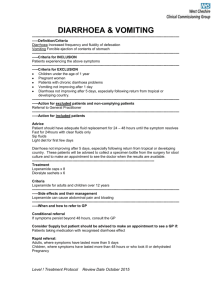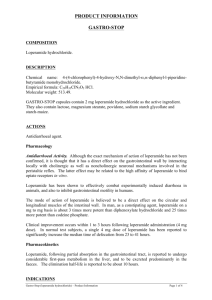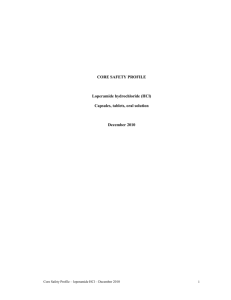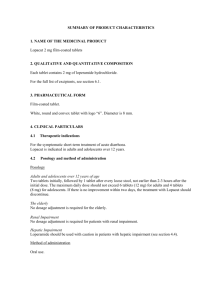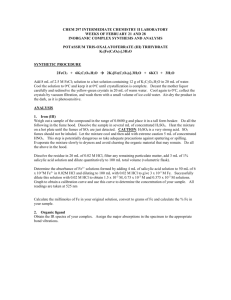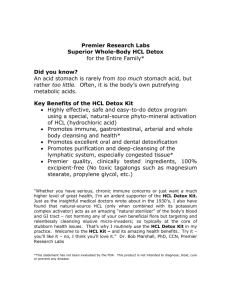CORE SAFETY PROFILE
advertisement
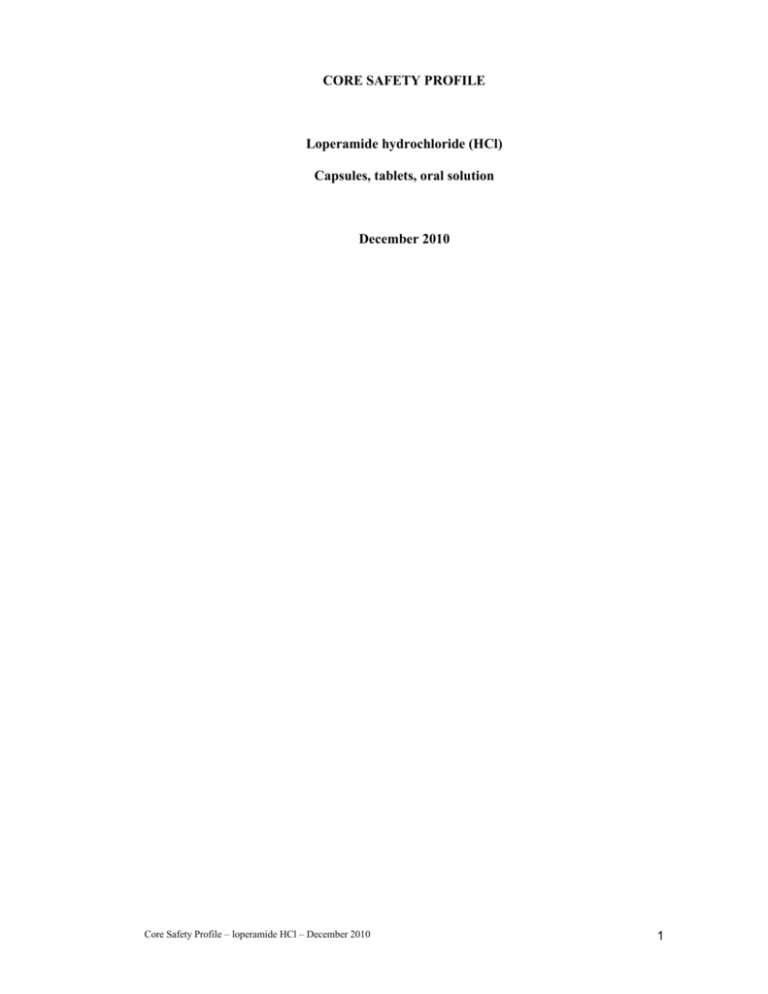
CORE SAFETY PROFILE Loperamide hydrochloride (HCl) Capsules, tablets, oral solution December 2010 Core Safety Profile – loperamide HCl – December 2010 1 4.2 POSOLOGY AND METHOD OF ADMINISTRATION Adults and Children 6-17 Years Orodispersible tablets The orodispersible tablet should be placed on the tongue. The tablet will dissolve and is to be swallowed with saliva. No liquid intake is needed for the orodispersible tablet. Capsules, Tablets The tablets and capsules should be taken with liquid. Acute diarrhea: the initial dose is 2 capsules or tablets (4 mg) for adults and 1 capsule or tablet (2 mg) for children; followed by 1 capsule or tablet (2 mg) after every subsequent loose stool. Chronic diarrhea: the initial dose is 2 capsules or tablets (4 mg) daily for adults and 1 capsule or tablet (2 mg) daily for children; this initial dose should be adjusted until 1-2 solid stools a day are obtained, which is usually achieved with a maintenance dose of 1-6 capsules or tablets (2 mg-12 mg) daily. The maximum dose for acute and chronic diarrhea is 8 capsules or tablets (16 mg) daily for adults; in children it must be related to the body weight (3 capsules or tablets/20 kg) but should not exceed a maximum of 8 tablets per day. Children 2 to 5 Years The orodispersible tablet should not be used in children under 6 years of age. Oral solution (2 mg/10 mL) 1 measuring cap (= 5 mL oral solution = 1 mg loperamide) per 10 kg body weight, 2 or 3 times daily. As soon as normal stools are passed or in the case no stools have been passed for more than 12 hours, the treatment with loperamide HCl must be discontinued. The maximum daily dose is 3 measuring caps (= 15 mL oral solution = 3 mg loperamide) per 10 kg body weight. Oral liquid (2 mg/15 mL) 1 measuring cup (= 7.5 mL oral liquid = 1 mg loperamide) per 10 kg body weight, 2 or 3 times daily. As soon as normal stools are passed or in the case no stools have been passed for more than 12 hours, the treatment with loperamide HCl must be discontinued. The maximum daily dose is 3 measuring cups (= 22.5 mL oral solution = 3 mg loperamide) per 10 kg body weight. Core Safety Profile – loperamide HCl – December 2010 2 Children Under 2 Years Loperamide HCl should not be used in children under 2 years of age. Elderly No dose adjustment is required for the elderly. Renal Impairment No dose adjustment is required for patients with renal impairment. Hepatic Impairment Although no pharmacokinetic data are available in patients with hepatic impairment, loperamide HCl should be used with caution in such patients because of reduced first pass metabolism. (see section 4.4 Special warnings and special precautions for use). 4.3 Contraindications Loperamide HCl is contraindicated in patients with a known hypersensitivity to loperamide HCl or to any of the excipients. Loperamide HCl should not be used in children under 2 years of age. The loperamide HCl orodispersible tablet should not be used in children under 6 years of age. Loperamide HCl should not be used as the primary therapy: o in patients with acute dysentery, which is characterized by blood in stools and high fever, o in patients with acute ulcerative colitis, o in patients with bacterial enterocolitis caused by invasive organisms including Salmonella, Shigella, and Campylobacter, o in patients with pseudomembranous colitis associated with the use of broad-spectrum antibiotics. Loperamide HCl should not be used when inhibition of peristalsis is to be avoided due to the possible risk of significant sequelae including ileus, megacolon and toxic megacolon. Loperamide HCl must be discontinued promptly when constipation, abdominal distension or ileus develop. Core Safety Profile – loperamide HCl – December 2010 3 4.4 Special warnings and special precautions for use Treatment of diarrhea with loperamide HCl is only symptomatic. Whenever an underlying etiology can be determined, specific treatment should be given when appropriate. In patients with diarrhea, especially in children, fluid and electrolyte depletion may occur. In such cases administration of appropriate fluid and electrolyte replacement therapy is the most important measure. Loperamide HCl should not be given to children aged 2 to 6 years of age without medical prescription and supervision. In acute diarrhea, if clinical improvement is not observed within 48 hours, the administration of loperamide HCl should be discontinued and patients should be advised to consult their physician. Patients with AIDS treated with loperamide HCl for diarrhea should have therapy stopped at the earliest signs of abdominal distension. There have been isolated reports of obstipation with an increased risk for toxic megacolon in AIDS patients with infectious colitis from both viral and bacterial pathogens treated with loperamide HCl. Although no pharmacokinetic data are available in patients with hepatic impairment, loperamide HCl should be used with caution in such patients because of reduced first pass metabolism. Patients with hepatic dysfunction should be monitored closely for signs of central nervous system (CNS) toxicity. Note: For OTC products, the last sentence in the above paragraph should be replaced with the following wording: This medicine must be used with caution in patients with hepatic impairment as it may result in a relative overdose leading to CNS toxicity. 4.5 Interaction with other medicinal products and other forms of interaction Non-clinical data have shown that loperamide is a P-glycoprotein substrate. Concomitant administration of loperamide (16 mg single dose) with quinidine, or ritonavir, which are both P-glycoprotein inhibitors, resulted in a 2 to 3-fold increase in loperamide plasma levels. The clinical relevance of this pharmacokinetic interaction with P-glycoprotein inhibitors, when loperamide is given at recommended dosages, is unknown. The concomitant administration of loperamide (4 mg single dose) and itraconazole, an inhibitor of CYP3A4 and P-glycoprotein, resulted in a 3 to 4-fold increase in loperamide plasma concentrations. In the same study a CYP2C8 inhibitor, gemfibrozil, increased loperamide by approximately 2-fold. The combination of itraconazole and gemfibrozil resulted in a 4-fold increase in peak plasma levels of loperamide and a 13-fold increase in total plasma exposure. These increases were not associated with central nervous system (CNS) effects as measured by Core Safety Profile – loperamide HCl – December 2010 4 psychomotor tests (i.e., subjective drowsiness and the Digit Symbol Substitution Test). The concomitant administration of loperamide (16 mg single dose) and ketoconazole, an inhibitor of CYP3A4 and P-glycoprotein, resulted in a 5-fold increase in loperamide plasma concentrations. This increase was not associated with increased pharmacodynamic effects as measured by pupillometry. Concomitant treatment with oral desmopressin resulted in a 3-fold increase of desmopressin plasma concentrations, presumably due to slower gastrointestinal motility. It is expected that drugs with similar pharmacological properties may potentiate loperamide’s effect and that drugs that accelerate gastrointestinal transit may decrease its effect. 4.6 Pregnancy and lactation Although there are no indications that loperamide HCl possesses teratogenic or embryotoxic properties, the anticipated therapeutic benefits should be weighed against potential hazards before loperamide HCl is given during pregnancy, especially during the first trimester. Small amounts of loperamide may appear in human breast milk. Therefore, loperamide HCl is not recommended during breast-feeding. Note: For OTC products, the last two paragraphs may be replaced with the following wording: It is not advisable to administer this medicine in pregnancy. Women who are pregnant or breast feeding should therefore be advised to consult their doctor for appropriate treatment. 4.7 Effects on ability to drive and use machines Tiredness, dizziness, or drowsiness may occur in the setting of diarrheal syndromes treated with loperamide HCl. Therefore, it is advisable to use caution when driving a car or operating machinery. Core Safety Profile – loperamide HCl – December 2010 5 4.8 Adverse reactions Adults and children aged ≥12 years The safety of loperamide HCl was evaluated in 3076 adults and children aged ≥12 years who participated in 31 controlled and uncontrolled clinical trials of loperamide HCl used for the treatment of diarrhoea. Of these, 26 trials were in acute diarrhoea (N=2755) and 5 trials were in chronic diarrhoea (N=321). The most commonly reported (i.e., ≥1% incidence) adverse drug reactions (ADRs) in clinical trials with loperamide HCl in acute diarrhoea were: constipation (2.7%), flatulence (1.7%), headache (1.2%) and nausea (1.1%). In clinical trials in chronic diarrhoea, the most commonly reported (i.e., ≥1% incidence) ADRs were: flatulence (2.8%), constipation (2.2%), nausea (1.2%) and dizziness (1.2%). Table 1 displays ADRs that have been reported with the use of loperamide HCl from either clinical trial (in acute or chronic diarrhoea or both) or post-marketing experience. The frequency categories use the following convention: very common (1/10); common (1/100 to <1/10); uncommon (1/1,000 to <1/100); rare (1/10,000 to <1/1,000); and very rare (<1/10,000). Table 1: Adverse Drug Reactions Indication System Organ Class Acute Diarrhoea (N=2755) Chronic Diarrhoea (N=321) Immune System Disorders Hypersensitivity reactiona, Anaphylactic reaction (including Anaphylactic shock)a, Anaphylactoid reactiona Nervous System Disorders Headache Common Uncommon Dizziness Uncommon Common Somnolencea Loss of consciousnessa, Stupora, Depressed level of consciousnessa, Hypertoniaa, Coordination abnormalitya Eye Disorders Miosisa Gastrointestinal Disorders Core Safety Profile – loperamide HCl – December 2010 Acute + Chronic Diarrhoea and postmarketing experienc e Rare Common Common Uncommon Rare Rare 6 Indication System Organ Class Acute Diarrhoea (N=2755) Chronic Diarrhoea (N=321) Acute + Chronic Diarrhoea and postmarketing experienc e Constipation, Nausea, Flatulence Common Common Common Abdominal pain, Abdominal Uncommon Uncommon Uncommon discomfort, Dry mouth Abdominal pain upper, Vomiting Uncommon Uncommon Dyspepsia Uncommon Uncommon Ileusa (including paralytic ileus), Megacolona (including toxic Rare megacolonb), Glossodyniaa,c Abdominal distension Rare Rare Skin and Subcutaneous Tissue Disorders Rash Uncommon Uncommon Skin and Subcutaneous Tissue Disorders Bullous eruptiona (including Stevens-Johnson syndrome, Toxic epidermal necrolysis and Erythema Rare multiforme), Angioedemaa, Urticariaa, Pruritusa Renal and Urinary Disorders Urinary retentiona Rare General Disorders and Administration Site Conditions Fatiguea Rare a: Inclusion of this term is based on post-marketing reports for loperamide HCl. As the process for determining post marketing ADRs did not differentiate between chronic and acute indications or adults and children, the frequency is estimated from all clinical trials with loperamide HCl combined, including trials in children ≤12 years (N=3683). b: See section 4.4 Special Warnings and Special Precautions for use. c: Reported for the orodispersible tablet only. For clinical trial ADRs where no frequency is presented, the term was not observed or considered an ADR for this indication. Core Safety Profile – loperamide HCl – December 2010 7 Paediatric population The safety of loperamide HCl was evaluated in 607 patients aged 10 days to 13 years who participated in 13 controlled and uncontrolled clinical trials of loperamide HCl used for the treatment of acute diarrhoea. In general, the ADR profile in this patient population was similar to that seen in clinical trials of loperamide HCl in adults and children aged 12 years and over. 4.9 Overdose Symptoms In case of overdose (including relative overdose due to hepatic dysfunction), CNS depression (stupor, coordination abnormality, somnolence, miosis, muscular hypertonia, and respiratory depression), urinary retention and ileus may occur. Children may be more sensitive to CNS effects than adults. Treatment If symptoms of overdose occur, naloxone can be given as an antidote. Since the duration of action of loperamide is longer than that of naloxone (1 to 3 hours), repeated treatment with naloxone might be indicated. Therefore, the patient should be monitored closely for at least 48 hours in order to detect possible CNS depression.
